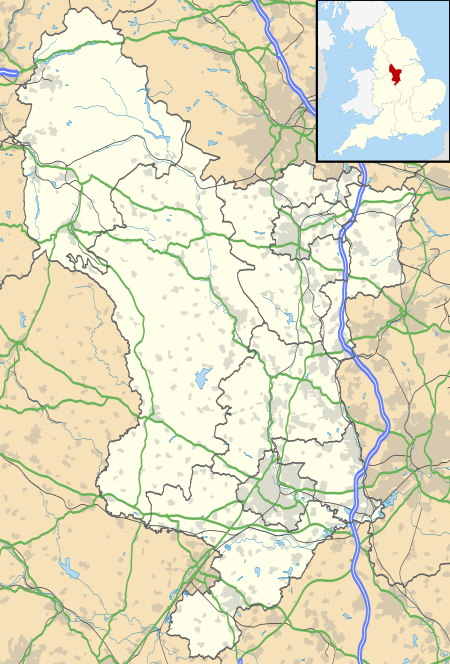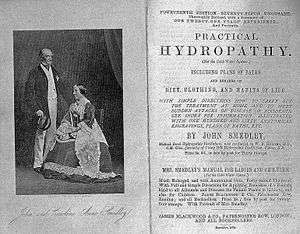County Hall, Matlock
The County Hall in Matlock, Derbyshire, is the offices and meeting place of Derbyshire County Council. It is a Grade II listed building.[1]
| County Hall, Matlock | |
|---|---|
 | |
| Location | Matlock, Derbyshire |
| Coordinates | 53.1422°N 1.5514°W |
| Built | 1867 |
Listed Building – Grade II | |
| Designated | 26 October 1972 |
| Reference no. | 1248195 |
 Location of County Hall, Matlock in Derbyshire | |
History

While on honeymoon in Switzerland in 1847, John Smedley had become seriously ill. On returning to England, he recuperated at the hydropathic establishment at Ben Rhydding in Yorkshire and later took the waters at Cheltenham. From then on, hydropathy was the greatest interest in Smedley's life.[2]
Matlock had developed as a spa town after thermal springs were discovered and the building on Matlock Bank was originally established as a small private hospital in 1851.[3] It was acquired by John Smedley, the hospital's medical adviser, in 1853.[3]
The earliest (western) section of the building seen today was built by Smedley in c. 1867. Much of today's building was added after Smedley’s death in 1874. The first phase, in 1881, included the entrance hall and staircase, now in the middle section. In 1886, the eastern section was added by architect George Statham of Nottingham. Later extensions include the tall chimney, impressive for its height on the already prominent site, along with boiler house and bath in 1894. The domed glass Winter Gardens, which housed a ballroom, and the northern block on the other side of Smedley Street were added in 1901. The northern block was linked by the unusual two storey bridge over Smedley Street.[4]
The facility soon became the largest hydropathic hotel in the town:
John Smedley was not the first to recognise and exploit the effects of water treatment on various illnesses, but it was Smedley whose conviction and enterprise established Hydrotherapy firmly in Matlock, and for a century made it one of the most celebrated centres of the "water cure". By the outbreak of war in 1939, Smedley's Hydro was world famous, its guests having included Robert Louis Stevenson, Sir Thomas Beecham, Ivor Novello, Jimmy Wilde, and Gilbert Jessop, to name but a few.[5]
During the Second World War, the site became the School of Military Intelligence. It operated until 1946.[6] Smedley's Hydro closed in the 1950s, and, after the County Hall in Derby was deemed too small, the hydro was purchased in 1955 by Derbyshire County Council as the new County Hall.[7]
Part of the County Hall complex is seen in Ken Russell's Oscar-winning 1969 film Women in Love.[8]
References
- Historic England. "Former Smedley's Hydropathic (County Council Offices), Matlock (1248195)". National Heritage List for England. Retrieved 13 August 2019.
- Derby Evening Telegraph; "There Was Red Tape at Smedley's Hydro Then", 3 January 1951 Archived 27 January 2009 at the Wayback Machine
- "A short history of County Hall, Matlock". Derbyshire Heritage. Retrieved 16 August 2019.
- "Matlock Bank Conservation Area Architecture". Derbyshire Dales District Council. Retrieved 1 January 2011.
- Lait, June (2006), A Brief History of Matlock (PDF), Matlock Civic Association & Matlock Town Council, pp. 1–2, retrieved 4 January 2010 Note: A publication date is not listed. But the Matlock essay refers to an ironmonger closure in 2006 (p.3). Another essay in the same article refers to a future development in 2007 (p.5). The publication date is thus likely to be late 2006.
- Nigel West, Historical Dictionary of British Intelligence (Scarecrow Press, 2014), 292.
- Country Life 15 August 1963 Archived 28 September 2011 at the Wayback Machine
- "The Town Of Matlock". Amber Valley. Retrieved 14 August 2019.
Further reading
- Smedley, Caroline Anne (1861). Ladies' Manual of Practical Hydropathy, for Female Diseases: Also, Directions to Mothers How to Carry Out Hydropathy for Their Children. London: W.S. Partridge. Retrieved 4 January 2010. (Full text at Internet Archive)
- Smedley, John (1864). Practical Hydropathy: Including Plans of Baths, and Remarks on Diet, Clothing, and Habits of Life (7th ed.). London: Job Caudwell. Retrieved 4 January 2010. (Full text at Internet Archive)
- Steer, Henry (1897). The Smedleys of Matlock Bank: Being a Review of the Religious and Philanthropic Labours of Mr. and Mrs. John Smedley. London: Elliot Stock. Retrieved 4 January 2010. (Full text at Internet Archive)